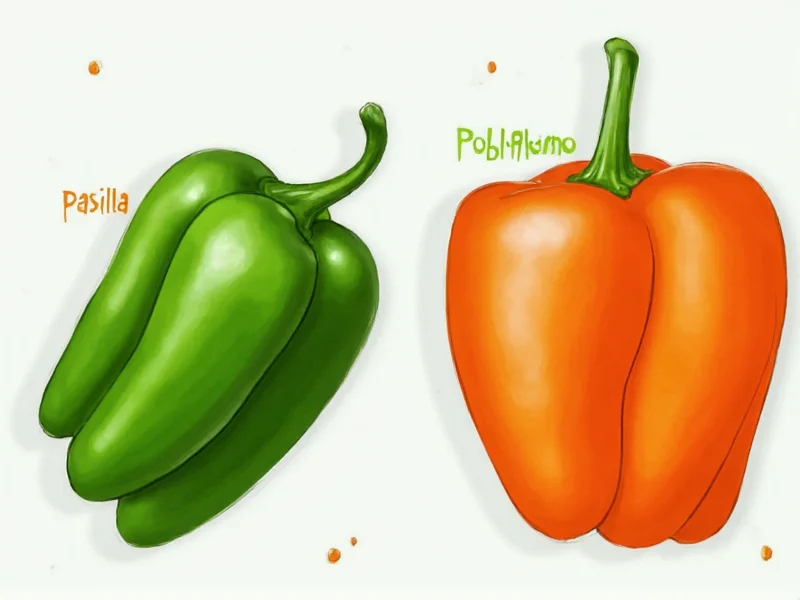Many home cooks struggle to distinguish pasilla and poblano peppers, especially in American grocery stores where labeling is frequently inaccurate. This confusion leads to recipe failures when substitutions aren't appropriate. Understanding the true characteristics of each pepper helps ensure authentic Mexican cuisine and successful cooking results.
Clearing Up the Naming Confusion
The most critical factor in understanding these peppers is recognizing the widespread mislabeling in the United States. What's often sold as "pasilla" in American markets is frequently actually a poblano, and vice versa. This misidentification stems from inconsistent translation and marketing practices that have persisted for decades.
True pasilla peppers are the dried form of the chilaca variety. When fresh, chilacas are long, thin, and dark green, turning nearly black when mature. Once dried, they become the wrinkled, dark brown pasilla peppers commonly used in Mexican mole sauces.
True poblanos, by contrast, are large, heart-shaped green peppers. When dried, they transform into anchos, not pasillas. This fundamental distinction explains why substituting one for the other can dramatically alter a dish's flavor profile.
Physical Characteristics Compared
| Characteristic | Pasilla Pepper | Poblano Pepper |
|---|---|---|
| Botanical Name | Chilaca (dried) | Capiscum annuum (fresh) |
| Shape | Long, thin, curved (6-8 inches) | Broad, heart-shaped (3-5 inches) |
| Color (Fresh) | Dark green to black | Bright to dark green |
| Color (Dried) | Dark brown to black | Brownish-red (then called ancho) |
| Heat Level | 1,000-2,500 SHU | 1,000-2,000 SHU |
Flavor Profiles and Heat Comparison
While both peppers fall in the mild to medium heat range, their flavor profiles differ significantly. Pasilla peppers offer complex notes of dried fruit, berries, and licorice with earthy undertones. This depth makes them ideal for rich sauces where their nuanced flavor can shine.
Poblano peppers provide a more straightforward earthy, slightly sweet flavor with grassy notes. Their thicker walls make them perfect for stuffing, as they maintain structure during cooking while imparting a gentle warmth without overwhelming heat.
Understanding the scoville heat units comparison between pasilla and poblano helps home cooks manage spice levels. Though their ranges overlap, pasillas typically reach slightly higher heat levels than poblanos, making them better suited for dishes requiring more pronounced warmth.
Common Mislabeling in US Markets
The confusion between these peppers reaches its peak in American grocery stores. Many supermarkets incorrectly label fresh poblanos as "pasilla" peppers, while authentic pasilla (dried chilaca) might be labeled as "mulato" or other names. This mislabeling creates significant challenges for cooks following traditional Mexican recipes.
When shopping for authentic pasilla vs poblano for mole recipes, look for these identifiers:
- True dried pasilla: Long, thin, dark brown to black, deeply wrinkled
- True fresh poblano: Large, heart-shaped, thick-walled, dark green
- Dried poblano (ancho): Broader than pasilla, reddish-brown, less wrinkled
Culinary Applications and Substitutions
Knowing the culinary differences between pasilla and poblano peppers helps determine appropriate substitutions. Pasillas excel in complex sauces like mole negro, where their fruity notes complement chocolate and spices. Their dried form integrates smoothly into liquid preparations.
Poblanos shine when roasted and stuffed (chiles rellenos), blended into creamy sauces, or added to soups and stews where their fresh flavor enhances other ingredients. Their thicker flesh holds up well to various cooking methods.
When substituting one for the other:
- Pasilla for poblano: Use rehydrated pasilla in sauces, but avoid for stuffing
- Poblano for pasilla: Not ideal in traditional moles, but works in simpler sauces
- Best alternative: Ancho pepper (dried poblano) for pasilla in many applications
Storage and Preparation Tips
Proper handling preserves each pepper's unique qualities. Fresh poblanos keep for 2-3 weeks refrigerated in plastic bags. For longer storage, roast, peel, and freeze them in airtight containers.
Dried pasillas maintain quality for 6-12 months when stored in airtight containers away from light and moisture. Before using, toast them lightly in a dry skillet to enhance flavors, then rehydrate in hot water for 20-30 minutes.
When working with either pepper, always wear gloves when handling, especially when cutting or seeding, as capsaicin can irritate skin and eyes. Never use plastic bags for storing fresh peppers, as trapped moisture accelerates spoilage.
Conclusion: Making the Right Choice for Your Recipe
Understanding the true difference between pasilla and poblano peppers empowers cooks to make informed decisions. While they're both valuable components of Mexican cuisine, they serve different purposes. When following authentic recipes, seek properly labeled peppers or understand which variety the recipe actually requires.
For traditional moles, seek genuine pasilla (dried chilaca). For stuffing or fresh applications, choose true poblanos. When shopping in the US, don't rely solely on labels—examine the physical characteristics to ensure you're getting the right pepper for your culinary needs.











 浙公网安备
33010002000092号
浙公网安备
33010002000092号 浙B2-20120091-4
浙B2-20120091-4